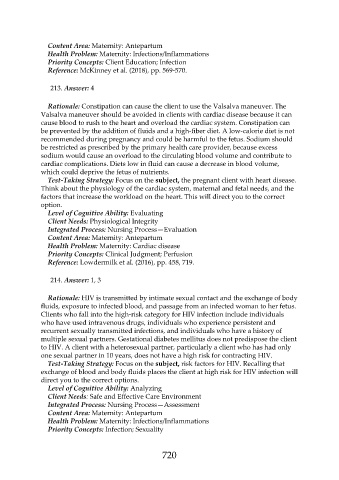Page 720 - Saunders Comprehensive Review For NCLEX-RN
P. 720
Content Area: Maternity: Antepartum
Health Problem: Maternity: Infections/Inflammations
Priority Concepts: Client Education; Infection
Reference: McKinney et al. (2018), pp. 569-570.
213. Answer: 4
Rationale: Constipation can cause the client to use the Valsalva maneuver. The
Valsalva maneuver should be avoided in clients with cardiac disease because it can
cause blood to rush to the heart and overload the cardiac system. Constipation can
be prevented by the addition of fluids and a high-fiber diet. A low-calorie diet is not
recommended during pregnancy and could be harmful to the fetus. Sodium should
be restricted as prescribed by the primary health care provider, because excess
sodium would cause an overload to the circulating blood volume and contribute to
cardiac complications. Diets low in fluid can cause a decrease in blood volume,
which could deprive the fetus of nutrients.
Test-Taking Strategy: Focus on the subject, the pregnant client with heart disease.
Think about the physiology of the cardiac system, maternal and fetal needs, and the
factors that increase the workload on the heart. This will direct you to the correct
option.
Level of Cognitive Ability: Evaluating
Client Needs: Physiological Integrity
Integrated Process: Nursing Process—Evaluation
Content Area: Maternity: Antepartum
Health Problem: Maternity: Cardiac disease
Priority Concepts: Clinical Judgment; Perfusion
Reference: Lowdermilk et al. (2016), pp. 458, 719.
214. Answer: 1, 3
Rationale: HIV is transmitted by intimate sexual contact and the exchange of body
fluids, exposure to infected blood, and passage from an infected woman to her fetus.
Clients who fall into the high-risk category for HIV infection include individuals
who have used intravenous drugs, individuals who experience persistent and
recurrent sexually transmitted infections, and individuals who have a history of
multiple sexual partners. Gestational diabetes mellitus does not predispose the client
to HIV. A client with a heterosexual partner, particularly a client who has had only
one sexual partner in 10 years, does not have a high risk for contracting HIV.
Test-Taking Strategy: Focus on the subject, risk factors for HIV. Recalling that
exchange of blood and body fluids places the client at high risk for HIV infection will
direct you to the correct options.
Level of Cognitive Ability: Analyzing
Client Needs: Safe and Effective Care Environment
Integrated Process: Nursing Process—Assessment
Content Area: Maternity: Antepartum
Health Problem: Maternity: Infections/Inflammations
Priority Concepts: Infection; Sexuality
720

